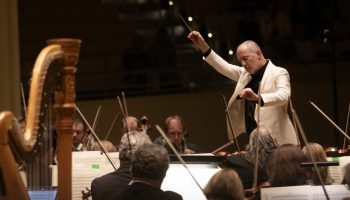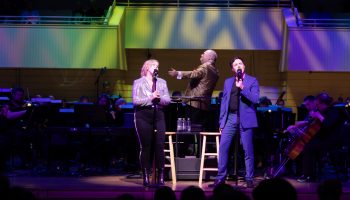Concerto for Violin and Orchestra in D major, op. 77 Johannes Brahms
Johannes Brahms was born on May 7, 1833, in Hamburg and died in Vienna on April 3, 1897. One of the dominant composers of the late 19th century, Brahms enriched the repertory for piano, organ, chamber music, chorus and orchestra. His only concerto for violin and orchestra was composed in the summer and early fall of 1878 in one of his favorite locales, Pörtschach am Wörthersee in Carinthia, a municipality in Austria. Brahms effected minor revisions after its premiere on Jan. 1, 1879, in Leipzig, Germany, with the composer conducting the Gewandhaus Orchestra with Joseph Joachim as soloist. It is scored for solo violin, two flutes, piccolo, two oboes, two clarinets, two bassoons, four horns, two trumpets, timpani and strings.
Few would deny that the violin concertos of Beethoven and Brahms stand at the pinnacle of the genre. It is also true that Beethoven’s work served as a model for Brahms, resulting in many clear points of contact between the works. Both concertos, for example, use the orchestra extensively, lending a symphonic quality to them. Each work not only explores the virtuosic capabilities of the violin, but also its lyrical side.
The first movement of both works follows the classical principle of tutti-solo alternation, a carryover from the Baroque ritornello form, in conjunction with the dialectic of sonata form. Yet, even while clinging to classical forms, both concertos ultimately transcend them. They are not just great violin concertos; they are superb musical compositions. As such, they tax their performers in both technical prowess and musicality.
Brahms’ concerto emerged from the master’s highly productive summer of 1878, a period that also produced the Symphony No. 2, the first sonata for violin and piano, and early work on the second piano concerto. The genesis and growth of Brahms’s Violin Concerto owes to the composer’s continuing friendship and professional affliation with the great violinist, Joseph Joachim. This virtuoso musician, who also was a composer of no small ability, offered much more than merely technical advice to the composer.
The Brahms-Joachim correspondence reveals much valuable insight into the concerto’s compositional genesis. One document, for example, shows Joachim dissuading Brahms from his plan to extend the work into a four-movement composition through the addition of a scherzo. Those familiar with Brahms’ Piano Concerto No. 2 will be aware that the composer successfully added such a movement in that work. But Joachim surely was right in his instincts regarding the Violin Concerto. The three-movement design was perfect as it stood.
The magical moments in Brahms’s Violin Concerto are almost too numerous to count, but a few are worth noting. The first comes very near the start of the opening Allegro non troppo, when after a purely diatonic D-major opening paragraph, an unexpected surprise comes in the form of a shudder — a counter- statement that starts in the foreign key of C major. The first entrance of the solo instrument takes place in a highly charged and dramatic D minor.
Also worth mentioning is the gentle and lyrical re-entry of the orchestra after the first movement’s cadenza — one of several instances of the influence of Beethoven’s Violin Concerto, a work that was also performed, at Joachim’s insistence, at the premiere. Joachim composed and performed his own cadenza, still used by many violinists, for the first performance of the Brahms. Both the cadenza and Joachim’s superb playing of it, according to a letter from Brahms to a friend, trampled over this poignant moment with immediate applause from the audience.
Speaking of lyricism, it is difficult to imagine a melody more sublime than the F-major oboe solo that inaugurates the Adagio second movement. Indeed, the scoring for woodwinds throughout this movement is incomparable.
This writer, for one, lives for the end of the movement’s introduction, when in an astonishing sequence, the solo flute drops from an F natural in a high register to a low F sharp, followed by a rest before resolving sweetly to a G. The next two measures land the music gently in its final cadence in the home key. This sequence is repeated later in the movement by the solo violin.
The finale is a gypsy-inspired Allegro giocoso, ma non troppo vivace, filled with technical challenges aplenty, as well as metrical subtleties, but never exceeding Brahms’s customary decorum. The movement is rounded out by a piquant and exciting coda, Poco più presto.
Symphony No. 9 in E minor, op. 95 (“From the New World”)
Antonin Dvořák
In early 1991, a three-story brick row house at 327 East 17th St. in Manhattan was declared a national landmark. A plaque above the first story declares that this was the New York home from 1892 to 1895 for the famous Czech composer Antonin Dvořák, who composed his Symphony No. 9 (“From the New World”) during a period from January to May 1893. Unfortunately, the brownstone was taken down to make room for the expansion of a nearby hospital and the corner near where it stood was renamed Dvořák Place. The composer settled in New York after the enthusiastic music patron, Jeannette Thurber, invited him to assume the directorship of the fledgling National Conservatory of Music, an institution that Thurber had founded in 1885. The conservatory reflected the patron’s liberal leanings, admitting women, minorities and students with disabilities — a most forward-thinking policy for its time. Shortly after taking up residence there, Dvorák communicated the following to a friend in Prague:
“We (the composer, his wife, and two children) live four minutes from my school in a very pleasant house. Mr. Steinway sent me a piano, free, so we have one good piece of furniture in the parlor. The rent is $80 a month, a lot for us, but a normal price here.”
Ever since it was first performed in New York City on Dec. 16, 1893, with Anton Seidl conducting the New York Philharmonic, Dvořák’s New World Symphony has remained an extremely popular orchestral work. The Czech master wrote two major works, as well as some smaller ones, during his extended visit to the United States, which included a short summer vacation spent with a colony of Czech immigrants in Spillville, Iowa. One of these compositions was the String Quartet, op. 96 (“American”), the other was this, his last symphony. Had Mrs. Thurber had her way, Dvořák would have also composed an opera based on Longfellow’s story of the Native Americans Minnehaha and Hiawatha, as she hoped that Dvořák would become the founder of a new American “school” of composition. As we shall see, at least some of Mrs. Thurber’s hopes found expression in his New World Symphony.
Folk music had always played a vital role in Dvořák’s music, and his “American” efforts serve to remind us that many folk musics have elements in common. The New World Symphony speaks its “American” with a distinctly Slavic accent. The title for the work, “From the New World” is the composer’s own, and he explained that it was inspired by “impressions and greetings” from his host country. Among these impressions must be counted the music of African-Americans, whose melodies Dvořák learned from one of his students at the conservatory, Henry Thacker Burleigh. It is difficult to determine just how well-versed Dvořák was in the authentic musical idiom of Native Americans, but the famous Largo movement of the New World Symphony was inspired, according to the composer, by a passage from Longfellow’s “The Song of Hiawatha.” The famous English horn theme of this Largo is still known by many people as a “spiritual” with the words “Goin’ Home.” The symphony is filled with many such appealing folk-like themes. Another notable moment comes in the first movement’s second theme group, where we hear, first in a solo flute, a tune that could have been inspired by the spiritual, “Swing low, sweet chariot.”
Another important element in the New World Symphony is its cyclic construction, in which a motto theme, first heard near the beginning of the first movement, is brought back at strategic moments in the subsequent movements. A careful listener will discern that this motto itself is the progenitor of other themes, thereby strengthening the thematic unity of the entire work. Dvořák also provides many masterful moments of orchestration and harmony, none, perhaps, more beautiful than the succession of brass chords at the beginning and end of the Largo — a gesture that makes a surprise appearance toward the end of the symphony’s last movement.
While the composer was still in America, he sent the manuscript for this symphony to his German publisher Simrock, who in turn showed them to Dvořák’s friend and adviser, Johannes Brahms. Brahms saw fit to make certain corrections and even some wholesale changes — especially in the finale — where he altered some of Dvořák’s tempos.
Musicologist David B. Levy is a professor of music at Wake Forest University in Winston-Salem, North Carolina. He has also taught at the Eastman School of Music of the University of Rochester and the University of North Carolina School of the Arts. A Beethoven scholar, he founded the New Beethoven Research group and has lectured widely throughout the United States and Europe. Levy will give a pre-concert lecture at 6:45 p.m. Thursday, June 28 in the Hurlbut Church sanctuary.




